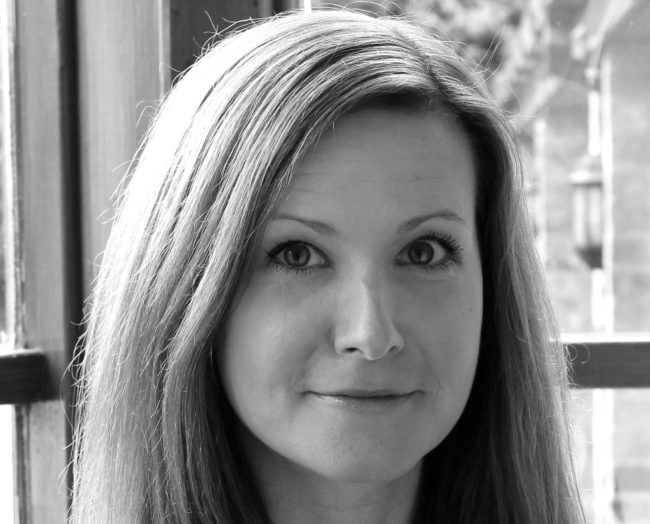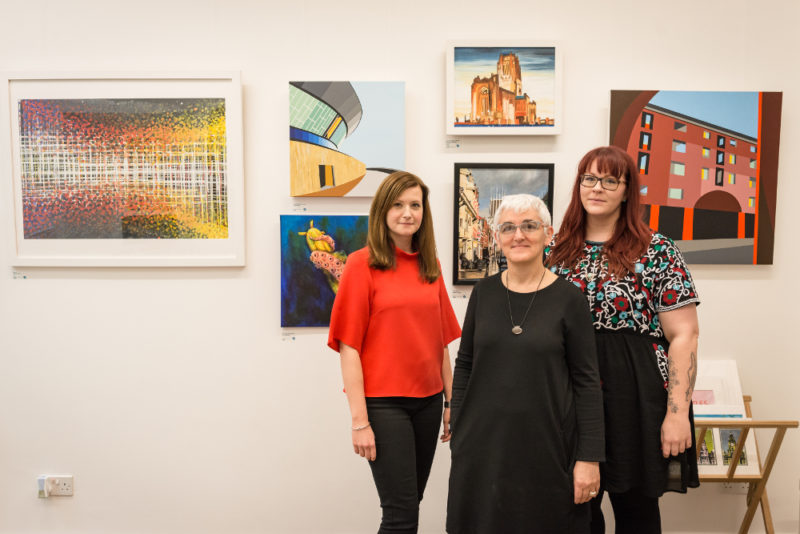Lucy is the founder and managing director of city centre-based dot-art which provides opportunities for local artists to make a living and reaches out to 70 schools in the region. Tony McDonough reports.

Schools are being forced to cut back on the teaching of arts and creative skills – just as the creative industry becomes one of the fastest-growing business sectors in the UK.
It’s an absurd situation. And Lucy Byrne, one of Merseyside’s leading creative and social entrepreneurs, goes further, describing the phenomenon as “terrifying”.
Warwickshire-born Lucy is the founder of Liverpool city centre-based dot-art, which provides a membership scheme for visual artists in the North West, supporting them and helping them sell or rent out their art via its commercial website and to corporate clients.
dot-art also operates a division set up as a social enterprise which offers other avenues for its artists to make a living and runs a programme to get schools in Merseyside and Cheshire involved in art.
Keeping the arts alive
Around 70 schools now take part in its annual inter-school arts competition, which has now been running for five years.
For many children in these schools it may be the only exposure to the visual arts they get during their hours in school.
“We developed the programme alongside local schools who told us ‘we love the arts but we’re really overworked and stressed and we have no time’,” explained Lucy.
Merseyside’s creative and digital business sector alone is worth £1bn a year to the city region economy and employs thousands of people.
This is projected to grow rapidly in the coming years but Lucy despairs at the thought that the school curriculum is actually cutting back on the teaching of the arts.
She said: “We were asked to run the arts competition by one school six years ago and things have got much worse now because of the reduction of arts in the school curriculum.

“We are finding it increasingly difficult. The schools want to take part but they are losing art teachers or having their budgets slashed.
“It is a really sad state of affairs and this is our small way of addressing that by exposing children to the opportunities that a creative path can offer you.
“They won’t all be artists but a creative education can open up doors to career paths and it is about highlighting the importance of that.
“The creative industries are the fastest-growing sector of the UK economy – 25% of jobs are going to be creative in the future and yet we are not educating our children in creative subjects at all – and that is terrifying.”
Recognising talent
The arts competition is split into two parallel competitions – the Liverpool city region and Cheshire East, Cheshire West and Warrington.
Schools sign up and dot-art creates a separate website where every school gets a separate page.
They take pictures of their their kids’ work and fill in a form about each piece of work and each page can feature up to 25 pieces.
Lucy added: “We then have a selection panel from Liverpool John Moores University, the Walker/NML and the Biennial who select the top three from each school in terms of quality and potential.
“We then have a month-long public voting period which sees the top three placed at the top of the page for each school.
“At the end of the month there is a winner from each school in a big exhibition and prize giving event at St George’s Hall in June where the Lord Mayor gives out certificates.
“We give prizes to primary and secondary schools and the pupils get prizes and the schools get prizes. The exhibition will be on for two weeks.
“We also have a partnership with Merseyrail and they create a digital version of the exhibition onto big boards and that goes onto Lime Street lower level station for a month in July.”
City of opportunity
Lucy was born and brought up in Warwickshire and came to Liverpool to study the history of art at the University of Liverpool.
After graduating she was urged by friends to kick-start her career in London. But, by then, she was already “hooked’ on Liverpool.
She said: “Liverpool had just won Capital of Culture and I just felt there are going to be some real opportunities here.”
Lucy started dot-art 11 years ago and was aware even then that Liverpool wasn’t a big art-buying city but felt there was enough potential to make the business work.
“There was a real energy and my overly-optimistic view was that if there were no commercial galleries in the city then that means I would be the first,” she explained.
“I knew it would be an uphill battle but I could see the city was regenerating and changing and there would be a market for art coming up behind that.”
Support for artists
The membership scheme sees around 100 artists pay a monthly fee which gives them access to a package of help, support, advice and opportunities.
Each artist gets their own page on the website where all their work is for sale, they get access to exhibition opportunities at the gallery as well as externally, as well as commissioning opportunities and renting their work out to businesses.
Taking a risk
The business is based in Queen Avenue, a tiny thoroughfare that runs between Castle Street and Dale Street in the city centre.
Although tucked away it feels like the perfect spot for a gallery. Lucy took over the current premises on a 10-year lease a year ago.
“Taking on the gallery was scary and a risk but I think we have been vindicated because the longer we have been here the more people have come in.”
“People like to see a front door and they like to speak to a human being. The website is essential but it is useless on its own. There has to be an integrated approach to what we do.
“I had my eye on this unit for six years and I think it is perfect for us.

“Selling art can be difficult. Everything that our artists produce, we try to sell and rent or do something with. The art market in Liverpool has not traditionally been a big one.
“If you set up a place like this and you just sit back and wait for people to come and buy art, that is not going to happen.
“We have lots of different schemes and ways in which we can work to help artists sell their work.
“And we also have very affordable artists’ studios just up the road in Waterloo.”
The artists can also supplement their earnings by teaching in dot-art’s range of art classes which are aimed at beginners and take place for three periods each year at locations such as Bluecoat, Sefton Park Palm House and this spring they will be expanded into North Liverpool.
Corporate connection
A key revenue-driver for dot-art is its link with the corporate world.
Businesses can simply buy pieces of art, they can commission bespoke piece and they can rent pieces.
It also works with developers or people who want a community art aspect to their space.
Said Lucy: “We are trying to explore lots of different opportunities and become a one-stop shop for businesses.
“Businesses know the environment they create in their workspace is important – but they don’t necessarily always know where to go and that is where we come in.
“You can rent for six, 12 or 18 months. The longer the rental period the cheaper the cost. We have one client we have had for seven years and they change the work every six months and take 25 pieces at a time.”
Future growth
Lucy is looking to spend more time developing relationships with businesses and said this would not be possible without the invaluable presence of Jessica Fairclough, who manages the gallery, and schools project manager, Carolyn Murray.
“There was a point where I was trying to do everything but I am so lucky to have people here now that I can trust and have made that process much easier for me than it might have been,” added Lucy.
She remains optimistic that dot-art can continue to stimulate an interest in art in Liverpool.
“We are still only scratching the surface with the gallery. We also have a framing service that brings a lot of people in,” she said.
“When I started I didn’t realise how hard it would be – it was just pure bloody-mindedness and determination that has got dot-art to this point.
“It all comes from a core of supporting artists and championing art as a key part of all our lives.”
